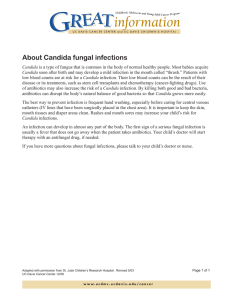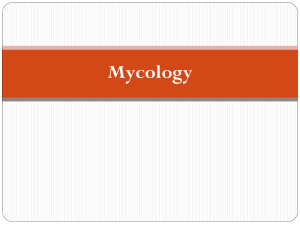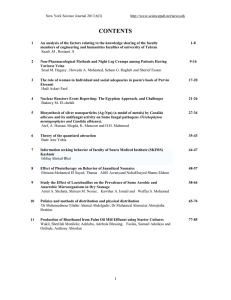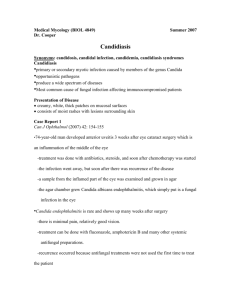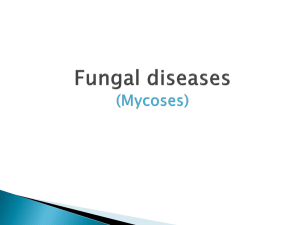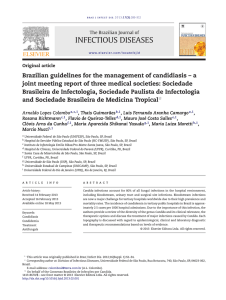Candidiasis
advertisement
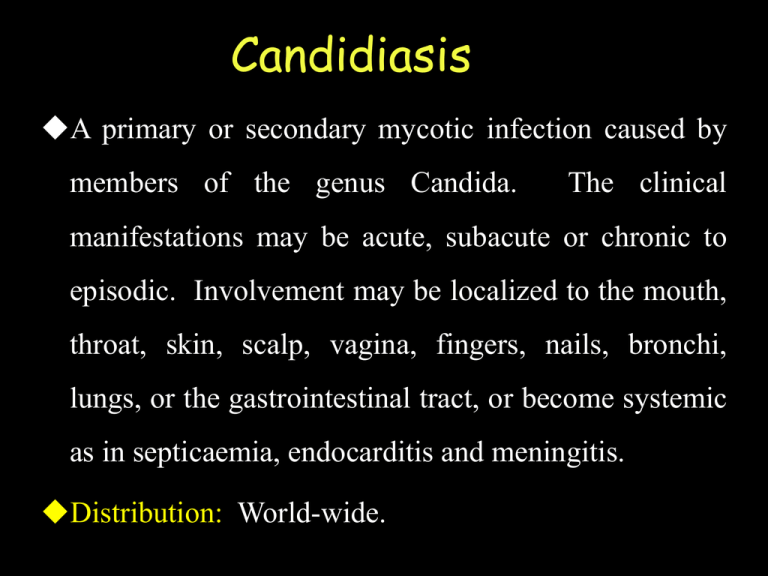
Candidiasis A primary or secondary mycotic infection caused by members of the genus Candida. The clinical manifestations may be acute, subacute or chronic to episodic. Involvement may be localized to the mouth, throat, skin, scalp, vagina, fingers, nails, bronchi, lungs, or the gastrointestinal tract, or become systemic as in septicaemia, endocarditis and meningitis. Distribution: World-wide. Candida MOST COMMON invasive fungal infection in immunocompromised patients 4th most common cause of nosocomial blood stream infection Species implicated in human disease most often: – – – – – – C. albicans C. tropicalis C. parapsilosis C. krusei (fluconazole resistant) C. glabrata C. lusitaniae (amphotericin B resistant) 2 Candida • Thick cell wall of mannan and glucan polysaccharides • Unicellular, budding (asexual) reproduction (blastospores) – Filament formation • Pseudohyphae (buds stay attached, constricted, chains of elongated blastospores) • Hyphae (buds germinate) 3 Cell wall Candida albicans 4 Candida Human commensal (endogenous) – skin, gastrointestinal, genitourinary tracts – 5 - 15% carriage rate in normal people – increased carriage with use of antibiotics Environmental (exogenous) – much less common – food, animals, soil hospital environment – outbreaks have occurred 5 Candida - Clinical • Mucous membrane infections – Thrush (oropharyngeal) – Esophagitis – Vaginitis • Cutaneous infections – Paronychia (skin around nail bed) – Onychomycosis (nails) – Diaper rash – Balanitis – Chronic mucotaneous candidiasis – Children with T-cell abnormality 6 Candida - Clinical • Urinary tract infection • Fungemia • Disseminated (systemic, invasive) infection – Immunocompromised patients • Cancer/chemotherapy • Neonatal candidiasis – – – – – – – Endophthalmitis (eye) Liver and spleen Kidneys Skin Brain Lungs Bone 7 Mucosal candidiasis Oral thrush Vaginal candidiasis 8 Cutaneous candidiasis Diaper dermatitis Balanitis 9 Cutaneous candidiasis Onychomycosis and paronychia Chronic mucocutaneous candidiasis 10 056 057 058 059 060 061 062 063 064 065 068 069 071 075 Candida - Laboratory Diagnosis 1 • Specimens - Blood, tissue (biopsy or autopsy), sterile fluid, urine, CSF, skin, respiratory secretions • Microscopy (direct on specimen - except blood and urine) – Gram stain, Calcofluor • Histopathology (tissues) – H & E - stain poorly – GMS, PMS - stain well 25 Candida - Laboratory Diagnosis 2 • Culture (all specimens) – Colony morphology • White, smooth, creamy, sometimes wrinkled – Laboratory identification • Unique color on chromagar • Chlamydospore production (terminal vesicle) • Germ tube production (in horse serum) – beginning of true hypha (no constriction) » C. albicans - Germ tube positive » Other Candida - Germ tube negative • Carbohydrate assimilation and fermentation (API 20C, Vitek2, RapID and reference) • Urea and nitrate • Microscopic morphology on Cornmeal Tween 80 26 Candida species Candida albicans Sabouraud Agar Morphology: Creamy white yeast, may be dull, dry irregular and heaped up, glabrous and tough Chromagar producing green pigmented colonies on specially designed medium to speciate certain yeasts based on color they produce 27 Candida species Germ tube: inoculation of yeast in horse serum incubated at 370C for 2 to 3 hours Germ Tube: Positive Germ tube is a continuous filament germinating from the yeast cell without constriction at the point of attachment. e.g. C. albicans, C. dubliniensis Germ Tube: Negative Shows constriction at the attachment site e.g. other Candida species, esp. C. tropicalis 28 Candida species Candida albicans Oxgall Agar large round and thick walled chlamydospores x400 Cornmeal Agar clusters of blastospores along pseudohyphae at regular intervals x1000 x400 x1000 29 076 077 078 079 080 081 082 083 084 086 087 092 093 Candida - Treatment • Remove infected intravenous lines • Antifungal therapy for systemic infection – Amphotericin B IV – Azoles (fluconazole, itraconazole, voriconazole, posaconazole) orally, intravenous – Flucytosine (only with Ampho B because of resistance) – Echinocandins (caspofungin, micafungin) 43 Candida antifungal resistance • Primary (inherent) resistance – C. lusitaniae (amphotericin B) – C. glabrata (fluconazole) – C. krusei (fluconazole) • Secondary (acquired) resistance – Fluconazole, other azoles – Amphotericin B – 5-FC 44 Candida antifungal susceptibility testing • Testing methodology – Reference broth microdilution (CLSI) – Commercial broth microdilution with alamar blue (Sensititre, YeastOne) – E-test – Disk diffusion (CLSI – Vitek 2 45 Candida antifungal susceptibility testing 46 Candida antifungal susceptibility testing 47

